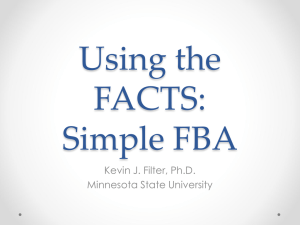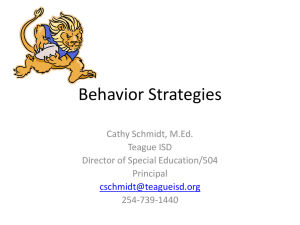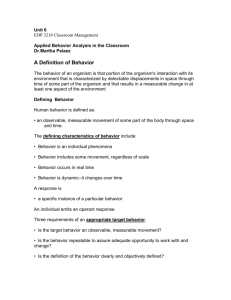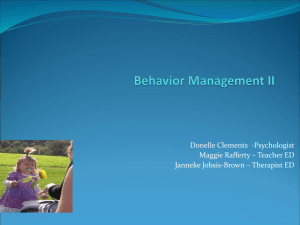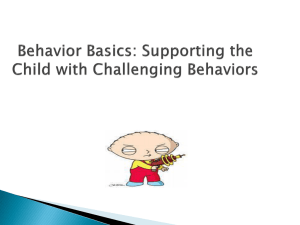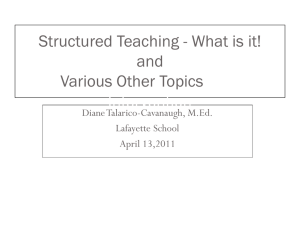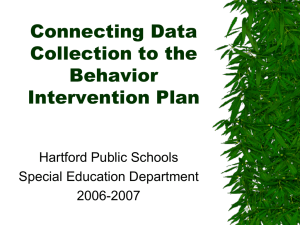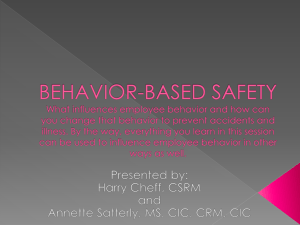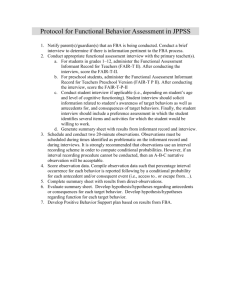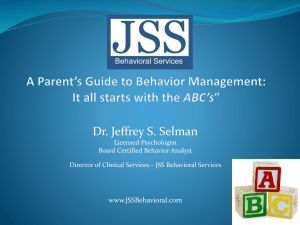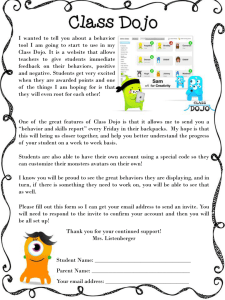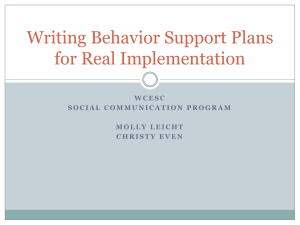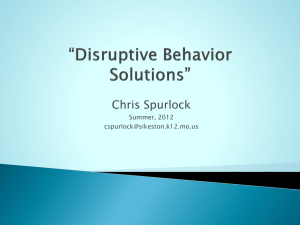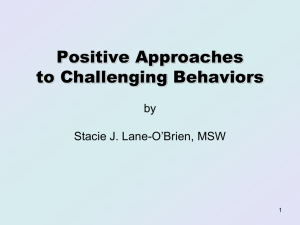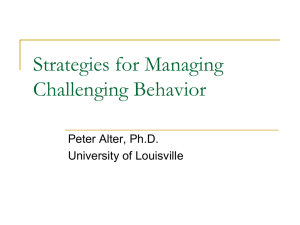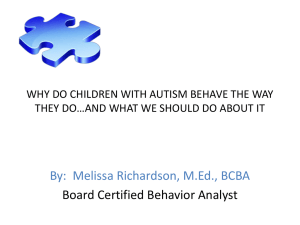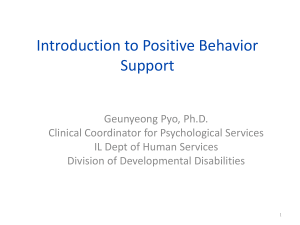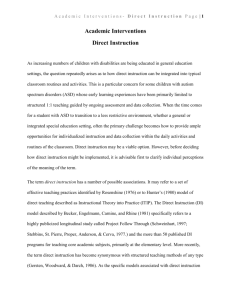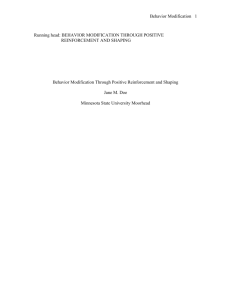Behavioral Strategies for Preschoolers
advertisement
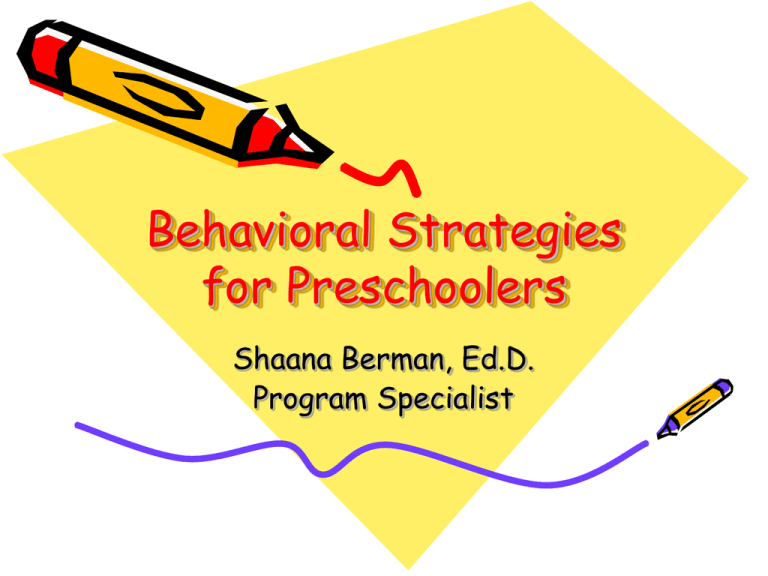
Behavioral Strategies for Preschoolers Shaana Berman, Ed.D. Program Specialist Agenda • • • • • • • • • Introductions Behaviorism and Applied Behavioral Analysis Behavior ABCs Functions of Behavior Teaching Alternative Behaviors Effective Instructions and Reinforcement The Home Environment Dos and Don’ts Final Thoughts Training Objectives • Analyze your child’s behavior in terms of the A-B-C Model • Identify common functions of behavior • Identify alternative replacement behaviors • Learn strategies for the home setting Why is My Child Doing That?! • What are some behaviors you are dealing with in the home or community settings? • How do we address behavior change? Behaviorism • Everything (e.g., ., thinking, feeling, doing), is a behavior • All behaviors are learned • Behaviors, both adaptive and maladaptive, are maintained by reinforcement Origins of Behaviorism • Classical Conditioning (Pavlov) – Showed a conditioned behavior can occur in response to a previously neutral stimulus or antecedent • Operant Conditioning (Skinner) – Showed that consequences can mediate the occurrence or form of a behavior Applied Behavioral Analysis • A scientific approach that uses the principles of behavior to promote socially significant behavior change. • ABA focuses on the A-B-C model A-B-C Behavior ABCs • A=Antecedent: what occurs right before the behavior; the instruction, can also be environmental or a physiological state (e.g., hunger). • B=Behavior: the learner’s response to the antecedent (can be considered as Correct, Incorrect, or a Non-Response) • C=Consequence: what occurs immediately after the learner responds (e.g., reinforcement, feedback, planned ignoring) Important Terms • Positive Reinforcement: Presentation of a desirable stimulus that increases a behavior (e.g., attention, praise, edible/candy, access to preferred toy) • Negative Reinforcement: removal of an aversive stimulus that increases a behavior (e.g, the pain of a headache is removed by taking an aspirin Important Terms • Extinction: Planned ignoring…not of the child, but of the undesirable behavior! • Prompting: Adding a cue to make the target behavior more likely to occur (e.g., visual, modeling, verbal cue) • Shaping: reinforcing successive approximations of a target behavior (e.g., Your Task Should you Choose to Accept It: Become a Behavior Detective: • Break down behaviors into – A=what was occurring right before the behavior? – B=what is the child doing? Be objective! – C=what did you do in response to the behavior? ABC Examples Antecedent Behavior Consequence Hungry Late for work See cookie See toy Mother leaves Mother leaves Cry Speed Say “cookie” Hit sibling Cry/tantrum Cry/tantrum Get bottle Get ticket Get cookie Get toy Mother returns Mother gone Group Exercise • • • • Break into groups of 2-3 Read the following scenarios Identify A, B and C Be prepared to share your responses! What Next? • We have analyzed the ABCs, now we must figure out the WHY. • All behavior has a function or purpose Functions of Behavior • Why is My Child Doing That?! – Ask Yourself: What function does this behavior serve? – What needs is my child trying to meet by using this behavior? Common Functions of Behavior • Obtain something (e.g., attention, toy, food, sensory etc.) • Escape/Avoid something (e.g., a person, place, activity, etc.) • Communication When a Child Has Special Needs • Lack of ability to communicate may lead to frustration and tantrums or aggression • Self-Stimulatory Behaviors serve a reinforcing function (you can set limits on and shape these) Identifying Functions • Whenever his mother calls, “bath time!” Johnny begins screaming, crying, and hiding under the bed. • Ella repetitively lines up her toy bears on the floor • Ryan hits his little brother for taking his toy *Can you identify these functions? Teaching Alternative Behavior • Once we have identified the function of an undesirable behavior, we must identify an appropriate alternative • Alternative replacement behaviors MUST match the FUNCTION of the original behavior! Alternative Behaviors Behavior Function Hit sibling Jump on bed Crying Rob Bank Communicate Sensory input Avoid Activity Get Money Alternative Use Words Trampoline Request Break Get a Job Exercise: Identifying Alternative Behaviors • • • • • • • Break in groups of 2-3 Discuss your child’s primary behaviors Determine a behavior you want to change Identify the Behavior Identify the Function Identify an Appropriate Alternative Be prepared to share your responses Manipulating A and C • Once you determine the function of a behavior, you can implement proactive and reactive strategies. • Proactive Strategies: Manipulating the antecedent to promote behavior change • Reactive Strategies: Manipulating the consequence to promote behavior change Practical Application • • • • • Giving an Effective Instruction Using Reinforcement Effectively Engineering the Home Environment Key Phrases Dos and Don'ts Effective Instructions • • • • • Get on eye level Ensure child is paying attention Use simple words and gestures Do not power struggle Ask yourself: Does my child understand what I am saying? • Be consistent! Consistency • All adults should be on the same page • If you say it, Do It! • Never give an instruction you can’t follow through on Using Reinforcement Effectively • Is the child motivated to comply? • Contract for reinforcement (e.g., give choices, ask what working for) • Reinforcement for young children must be immediate…they cannot delay gratification Using Reinforcement Effectively • • • • Vary it! Reinforce contingently Give tangibles when appropriate Connect behaviors to outcomes specifically (“I like how you tried a new food at dinner! You earned your star!”) • *See handout: Token Economies Engineering the Home Environment • Clean • Organized • Use Visuals (e.g., star chart) • Enough Space • Family Rules • Routines *See Handout: Environmental Checklist Key Phrases • • • • • • First…then… I’ll wait until you are ready That’s not ok Try Again What are you working for? You may do it yourself or I can help you Dos and Don’ts • Do: – Know your child! – Give choices – Allow Contracting – Establish contingency (If…then…) • Don’t: – Power Struggle – Use punishment – Fail to follow through – Fail to reward contingent on desirable behavior *See handout: Nanny 911 Commandments Final Thoughts… “If a child can’t learn the way we teach, maybe we should teach them the way they learn…” -Ignacio Estrada

